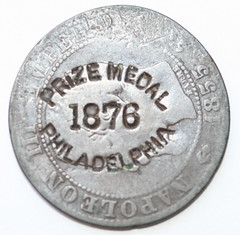
PREV ARTICLE
NEXT ARTICLE
FULL ISSUE
PREV FULL ISSUE
IS 1876 PRIZE COUNTERSTAMP OF BRITISH ORIGIN?Regarding Dave Schenkman's counterstamped 5-Centimes, Paul Bosco writes:
It became illegal to deface British bronze coins. (Smaller coins in bronze replaced the earlier coppers, beginning 1860.) However, Continental "5" and "10" coins --Centimes, Centesimi, Stotinki, Para, etc.-- were issued by Latin Monetary Union countries. These circulated in England, where they were just about the same size as the Halfpenny and Penny bronze coins. Advertisers stamped them and put them into circulation. This piece may relate to a British product that won an award at the Expo in Philly. At this time, I haven't been able to check if Scott lists it. It may be some kind of trial, never issued in an effective quantity for advertising. These kinds of pieces were not stamped on both sides, so this anonymous piece does not make sense. Nonetheless, it very much has the right look for inclusion in the series in question. Thanks! That's a very plausible explanation of the origin of this piece. The Scott book is British Countermarks on Copper and
Bronze Coins, 1975. I found it listed in the bibliography for Greg Brunk's 2003 book. Merchant and Privately Countermarked Coins. I
didn't find this "Prize Medal" listed in Brunk's index. -Editor
To read the earlier E-Sylum articles, see:
Wayne Homren, Editor The Numismatic Bibliomania Society is a non-profit organization promoting numismatic literature. See our web site at coinbooks.org. To submit items for publication in The E-Sylum, write to the Editor at this address: whomren@gmail.com To subscribe go to: https://my.binhost.com/lists/listinfo/esylum All Rights Reserved. NBS Home Page Contact the NBS webmaster 
|
